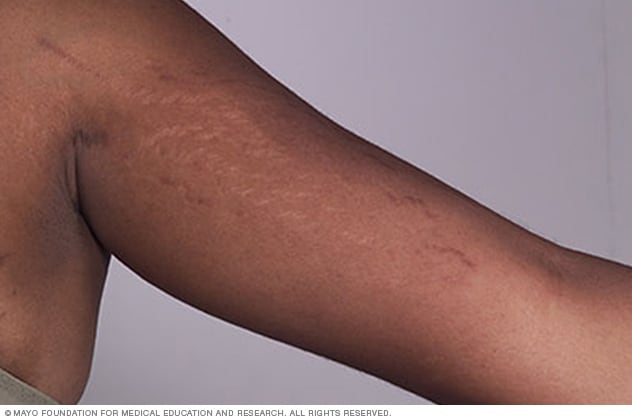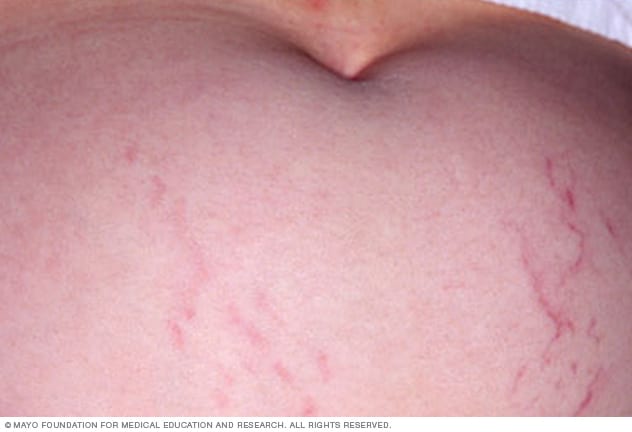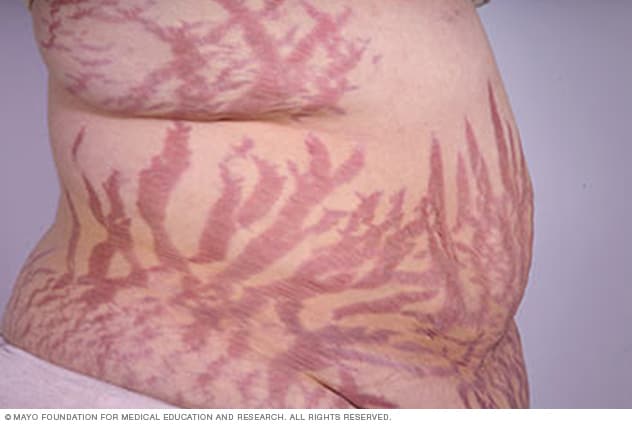Stretch marks
Overview
Stretch marks (striae) are indented streaks that appear on the abdomen, breasts, hips, buttocks or other places on the body. They're common in pregnant women, especially during the last trimester. Stretch marks aren't painful or harmful, but some people don't like the way they make their skin look.
Stretch marks don't require treatment. They often fade over time, with or without treatment. They may never disappear completely.

Symptoms
Stretch marks don't all look alike. They vary depending on how long you've had them, what caused them, where they are on your body and the type of skin you have. Common variations include:
- Indented streaks or lines on the abdomen, breasts, hips, buttocks or other places on the body
- Pink, red, discolored, black, blue or purple streaks
- Bright streaks that fade to a lighter color
- Streaks covering large areas of the body


When to see a doctor
See your health care provider if you're concerned about the appearance of your skin or if the stretch marks cover large areas of your body. Your health care provider can help determine the cause of the stretch marks and discuss treatment options.
Causes
The cause of stretch marks is stretching of the skin. Their severity is affected by several factors, including your genetics and the degree of stress on the skin. Your level of the hormone cortisol also might play a role. Cortisol is a hormone produced by the adrenal glands. It weakens elastic fibers in the skin.
Risk factors
Anyone can develop stretch marks, but some factors increase your likelihood of getting them, including:
- Being female
- Having a personal or family history of stretch marks
- Being pregnant, especially if you're young
- Rapid growth in adolescence
- Rapidly gaining or losing weight
- Using corticosteroids
- Having breast enlargement surgery
- Exercising and using anabolic steroids
- Having a genetic disorder such as Cushing syndrome or Marfan syndrome
Diagnosis
Stretch marks don't usually need to be diagnosed. Your health care provider might examine your skin and review your medical history. If your health care provider suspects an increase in your level of the hormone cortisol, you might be offered more tests.
Treatment
Stretch marks don't require treatment. They are harmless and often fade over time. Treatment can make them fade, but they may never completely disappear.
The following treatments are among those available to help improve the appearance and texture of stretch marks. None has been proved to be more consistently successful than the others.
-
Retinoid cream. Derived from vitamin A, retinoids — such as tretinoin (Retin-A, Renova, Avita) — that you apply to your skin may improve the appearance of stretch marks less than a few months old. Tretinoin, when it works, helps to rebuild a protein in the skin called collagen, making the stretch marks look more like your normal skin. Tretinoin can irritate your skin.
If you're pregnant or nursing, talk with your health care provider about other treatment options, because possible side effects of retinoid cream may affect the baby.
- Light and laser therapies. A variety of light and laser therapies are available that might stimulate growth of collagen or promote elasticity. Your health care provider can help you determine which technique is right for you.
- Microneedling. This treatment involves a hand-held device with tiny needles that stimulate collagen growth. This technique has less risk of skin color changes than does laser therapy so is the preferred first approach for people with darker skin.
Work with your health care provider to choose the right treatment or combination of treatments for you. Factors to consider include:
- How long you've had the stretch marks
- Your skin type
- Convenience, as some therapies require repeated visits to the clinic
- Cost, as treatments to improve how the skin looks (cosmetic therapies) often aren't covered by medical insurance
- What you expect your skin to look like after treatment
Self care
Many creams, ointments and other products claim to prevent or treat stretch marks. These include products made of cocoa butter, vitamin E and glycolic acid. They aren't harmful, but they probably won't help much either.
Stretch marks usually fade over time and don't need self-care or home therapy.
Alternative medicine
The idea that you can prevent or treat stretch marks by rubbing creams, oils or lotions on your skin is not supported by strong evidence.
If you're pregnant, check with your health care provider before using alternative products that claim to treat or prevent stretch marks.
Preparing for your appointment
If you seek treatment for stretch marks, prepare for your appointment by listing some basic questions to ask your health care provider, including:
- What is likely causing my stretch marks?
- Other than the most likely cause, what are other possible causes for my symptoms?
- What are my treatment options and the pros and cons for each?
- What results can I expect?
Your health care provider is likely to ask you several questions, such as:
- When did you first notice the stretch marks?
- Do you have other symptoms?
- What medicines are you taking?
- Do you regularly use cortisone skin creams?
Last Updated Jan 12, 2023
© 2024 Mayo Foundation for Medical Education and Research (MFMER). All rights reserved. Terms of Use



